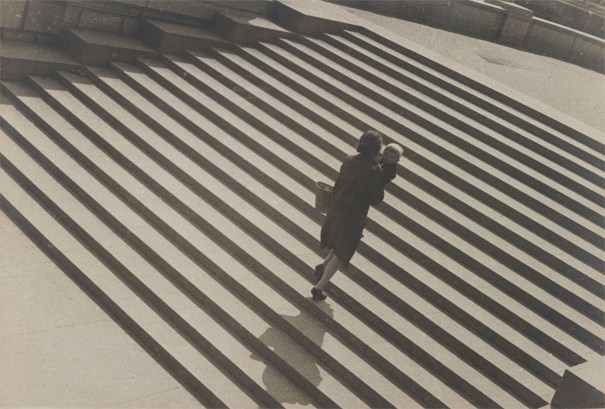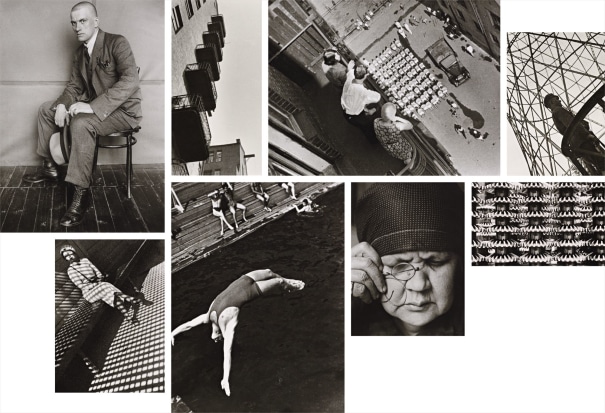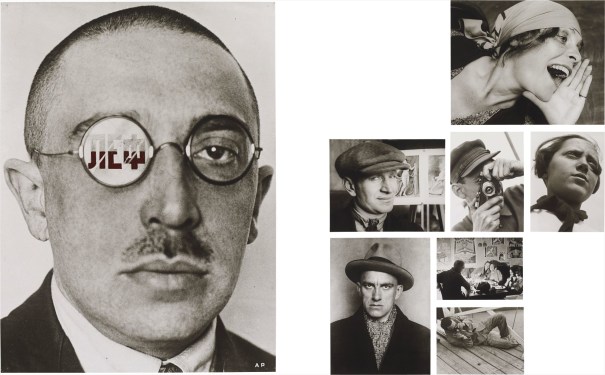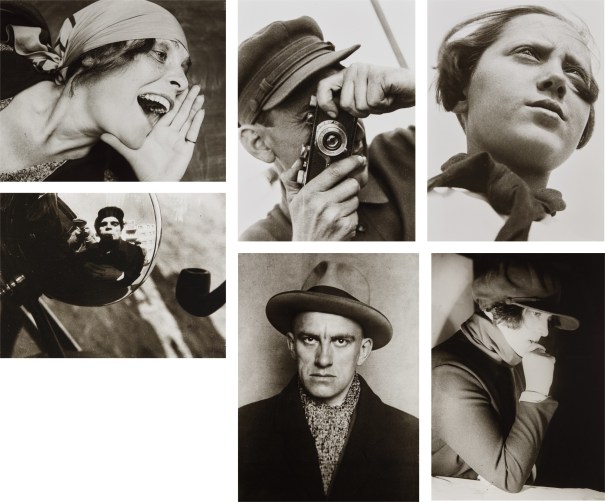THE ARC OF PHOTOGRAPHY: A PRIVATE EAST COAST COLLECTION Alexander Rodchenko Peizazh (The View) 1925 Gelatin silver print. 6 1/2 x 8 7/8 in. (16.5 x 22.5 cm). Signed and dated in pencil on the mount; titled and dated in pencil, credit stamp and a collection stamp attributed to Rodchenko and Stepanova on the reverse of the mount.
Provenance Robert Mann Gallery, New York Literature Lavrentiev, Alexander Rodchenko Photography 1924-1954, pl. 155 for a variant there titled and dated On the embankment of the Moskva river, Winter 1926 Catalogue Essay The Russian Revolution of 1917, during which the Tsarist autocracy was overthrown and ultimately replaced by a Communist Bolshevik government, engendered a group of artists, such as Alexander Rodchenko who closely adhered to the new Socialist norms, and contributed their skills to propagate it. As a medium, photography was highly favored for its documentarian link to reality and subsequent accessibility in print media, aligning itself with the decentralizing, anti-elitist, anti-capitalist premises of the new regime. Accordingly, in his portraits Rodchenko repudiated the former Mannerist approach to photography in favor of a reductivist, honest approach. Between 1924 and 1928 Rodchenko photographed the many writers, poets, artists and moviemakers affiliated with Left Front of Art. Among those who sat for a portrait by Rodchenko were the poet Valdimir Mayakovsky, the architect Alexander Vesnin, and, as seen in lot 246, the filmmaker Esther Shub. As a member of the Goskino film company promoting the film reel’s instant portal to reality, Shub elected to create a retrospective cinematic study of pre-Revolution Soviet Union. The end result was the documentary trilogy: The Fall of the Romanov Dynasty (1927), The Great Road (1927), and Lev Tolstoy and the Russia of Nicolai II (1928), which cemented her reputation as the foremost Soviet woman filmmaker of her day. In lot 246, Shub is seen with her elbow strongly planted on top of a counter, her fist strongly supporting her chin, and a working class cap framing her face. Rodchenko chose to strip his portrait of Shub of any superfluous variables, allowing her essence to emerge in its simplest and most unassuming form. In fact, it is known that many of Rodchenko’s portraits were taken amidst a friendly chatter, during which his decision to press the button to photograph would go unannounced. That allowed him to catch his sitter relaxed, consequently revealing their true self. As a vital contributor to the nascent Socialist art scene, Rodchenko’s scenes of the outdoors were largely influenced by Russian Formalism. As an art movement, its inclination was to “make strange”, presenting a seemingly familiar scene in an unexpected manner that would invoke an immediate interaction between the viewer and the artwork. The sense of scale, depth and orientation would therefore be challenged and despite the final image were imbued with an immediate and refreshing shock. In Peizazh, 1926, (lot 248), the dramatic foreshortening of the ledge on the left and the plunging depth beyond it add an element of disorientation that effectively thrusts the viewers into the scene, encouraging engagement. By the 1930’s, the appeal and mass accessibility of photography was undeniable, becoming the foremost vessel for Socialist propaganda. The core group of post-Revolution photographers had dispersed and diluted, and Rodchenko’s repertoire expanded to include jobs for the magazine Sovietskoe Foto, turning his lens to parades and sports activities at Red Square, as seen in lot 247. At the time sports such as gymnastics had a dual appeal—at once an emblem of youth, agility and synchronicity; but also a symbol of freedom for having been accessible only to the upper echelon prior to the Revolution. Moreover, engaging in sports, especially within a public setting, became a metaphor for national pride and a willingness to defend the country. Rodchenko’s image successfully captures the sense of renewed vitality and enthusiasm that engulfed the country without relinquishing his idiosyncratic eye and penchant for immediacy and frontality. Read More
THE ARC OF PHOTOGRAPHY: A PRIVATE EAST COAST COLLECTION Alexander Rodchenko Peizazh (The View) 1925 Gelatin silver print. 6 1/2 x 8 7/8 in. (16.5 x 22.5 cm). Signed and dated in pencil on the mount; titled and dated in pencil, credit stamp and a collection stamp attributed to Rodchenko and Stepanova on the reverse of the mount.
Provenance Robert Mann Gallery, New York Literature Lavrentiev, Alexander Rodchenko Photography 1924-1954, pl. 155 for a variant there titled and dated On the embankment of the Moskva river, Winter 1926 Catalogue Essay The Russian Revolution of 1917, during which the Tsarist autocracy was overthrown and ultimately replaced by a Communist Bolshevik government, engendered a group of artists, such as Alexander Rodchenko who closely adhered to the new Socialist norms, and contributed their skills to propagate it. As a medium, photography was highly favored for its documentarian link to reality and subsequent accessibility in print media, aligning itself with the decentralizing, anti-elitist, anti-capitalist premises of the new regime. Accordingly, in his portraits Rodchenko repudiated the former Mannerist approach to photography in favor of a reductivist, honest approach. Between 1924 and 1928 Rodchenko photographed the many writers, poets, artists and moviemakers affiliated with Left Front of Art. Among those who sat for a portrait by Rodchenko were the poet Valdimir Mayakovsky, the architect Alexander Vesnin, and, as seen in lot 246, the filmmaker Esther Shub. As a member of the Goskino film company promoting the film reel’s instant portal to reality, Shub elected to create a retrospective cinematic study of pre-Revolution Soviet Union. The end result was the documentary trilogy: The Fall of the Romanov Dynasty (1927), The Great Road (1927), and Lev Tolstoy and the Russia of Nicolai II (1928), which cemented her reputation as the foremost Soviet woman filmmaker of her day. In lot 246, Shub is seen with her elbow strongly planted on top of a counter, her fist strongly supporting her chin, and a working class cap framing her face. Rodchenko chose to strip his portrait of Shub of any superfluous variables, allowing her essence to emerge in its simplest and most unassuming form. In fact, it is known that many of Rodchenko’s portraits were taken amidst a friendly chatter, during which his decision to press the button to photograph would go unannounced. That allowed him to catch his sitter relaxed, consequently revealing their true self. As a vital contributor to the nascent Socialist art scene, Rodchenko’s scenes of the outdoors were largely influenced by Russian Formalism. As an art movement, its inclination was to “make strange”, presenting a seemingly familiar scene in an unexpected manner that would invoke an immediate interaction between the viewer and the artwork. The sense of scale, depth and orientation would therefore be challenged and despite the final image were imbued with an immediate and refreshing shock. In Peizazh, 1926, (lot 248), the dramatic foreshortening of the ledge on the left and the plunging depth beyond it add an element of disorientation that effectively thrusts the viewers into the scene, encouraging engagement. By the 1930’s, the appeal and mass accessibility of photography was undeniable, becoming the foremost vessel for Socialist propaganda. The core group of post-Revolution photographers had dispersed and diluted, and Rodchenko’s repertoire expanded to include jobs for the magazine Sovietskoe Foto, turning his lens to parades and sports activities at Red Square, as seen in lot 247. At the time sports such as gymnastics had a dual appeal—at once an emblem of youth, agility and synchronicity; but also a symbol of freedom for having been accessible only to the upper echelon prior to the Revolution. Moreover, engaging in sports, especially within a public setting, became a metaphor for national pride and a willingness to defend the country. Rodchenko’s image successfully captures the sense of renewed vitality and enthusiasm that engulfed the country without relinquishing his idiosyncratic eye and penchant for immediacy and frontality. Read More

.jpg)






Testen Sie LotSearch und seine Premium-Features 7 Tage - ohne Kosten!
Lassen Sie sich automatisch über neue Objekte in kommenden Auktionen benachrichtigen.
Suchauftrag anlegen